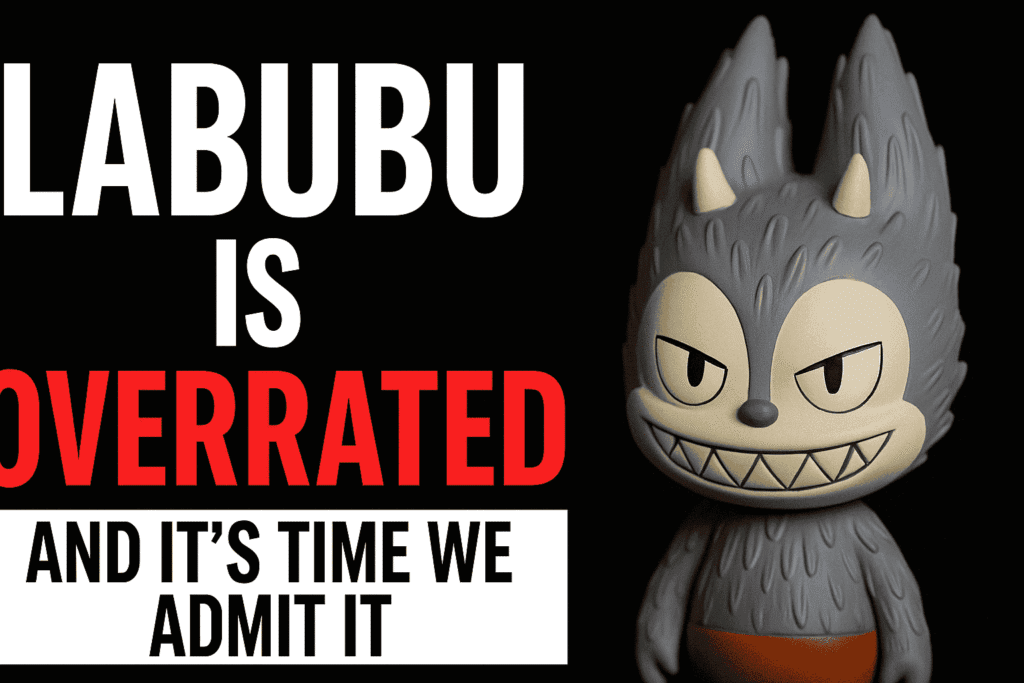Labubu has become a symbol of something far bigger than toys — it’s a mirror of how today’s hype-driven culture confuses obsession with value.
And let’s be brutally honest: Labubu is not iconic, it’s manufactured hype.

What looks like a cultural phenomenon is actually a case study in artificial demand and emotional manipulation. The problem isn’t Labubu’s design; it’s the delusion around it.
Every time a new figure drops, social media explodes.
Not because people genuinely resonate with the character’s story or its “artistic value,” but because everyone wants to be part of the next viral collectible wave.
Labubu doesn’t earn attention through substance — it weaponizes scarcity to simulate meaning. You’re not buying meaning; you’re buying FOMO.
It’s Not Art, It’s Strategy
Let’s break the illusion: Labubu didn’t organically “rise to fame.” It was calculated.
The entire ecosystem — from blind boxes and secret editions to surprise drops and timed releases — is built on behavioral psychology, not artistic excellence.
This isn’t Toy Story. This is Vegas with vinyl figures.
The moment you have to gamble to get a toy, it’s no longer about collecting — it’s about addiction.
And yet, collectors line up, credit cards ready, hoping to “score” something that was mass-produced to feel rare.
That’s not scarcity.
That’s manufactured desperation.
Design-wise, Labubu is intentionally absurd. Its odd proportions, chaotic expressions, and surreal styling scream, “Look how weird I am — I must be special.”
But being different isn’t the same as being meaningful. Its uniqueness is a costume, not a message.
Status, Not Sentiment
Let’s stop pretending this is about nostalgia or artistic connection. Labubu’s rise has nothing to do with genuine emotional attachment.
It’s about social capital. People don’t post Labubu hauls online to share joy — they post to flex.
They don’t love it; they love the attention that comes with owning it before you do.
There’s a reason half the Labubu figures never even leave their boxes. Because the value isn’t in the toy — it’s in the brag.
It’s about the Instagram post, the Reddit karma, the TikTok unboxing. Strip that away, and very few would care. If Labubu didn’t trend, it wouldn’t sell.
The Resale Circus
If Labubu had true collector value, its worth would be driven by its story, legacy, or craftsmanship.
But the entire market is ruled by price spikes and panic buying. Resellers treat it like crypto.
People buy not because they love it, but because they expect it to double in price next week. That’s not collecting — it’s hoarding with a price tag.
And worse, people justify it. “It’s an investment.” No — it’s a bubble.
And when it pops, the shelves full of “limited edition” Labubu figures will mean nothing.
Because you can’t sustain emotional connection on artificial hype forever.
Manufactured Community
People claim Labubu has built a “community,” but that’s only half true. It’s built a marketplace disguised as a fandom.
The forums, the Discord groups, the pop-up meetups — they don’t revolve around love for the character, they revolve around hunting, buying, selling.
he moment the market slows, so will the enthusiasm. And when that happens, where’s the legacy?
True collectible icons — from LEGO to vintage Barbies to Pokémon — built their place through storytelling, nostalgia, and cultural resonance.
Labubu skipped that part and replaced it with mystery boxes, influencer seeding, and resale frenzy. It’s not legacy. It’s a shortcut.
The Truth Most Won’t Admit
Labubu has become a symbol of how easily people mistake noise for value.
It’s not a collectible revolution — it’s a high-speed carousel of hype, designed to keep people dizzy, spending, and addicted.
The sooner we admit that, the sooner we stop mistaking marketing for meaning.
Yes, people will defend Labubu.
They’ll say, “You just don’t get it,” or “It’s cute, that’s enough.” But surface-level aesthetics can’t hold long-term weight.
And chasing clout through collectibles isn’t connection — it’s consumerism in costume.
We’re not angry at the toy. We’re exhausted by the cycle — the engineered scarcity, the blind validation, the performative joy.
We deserve better. And so does the future of collecting.
